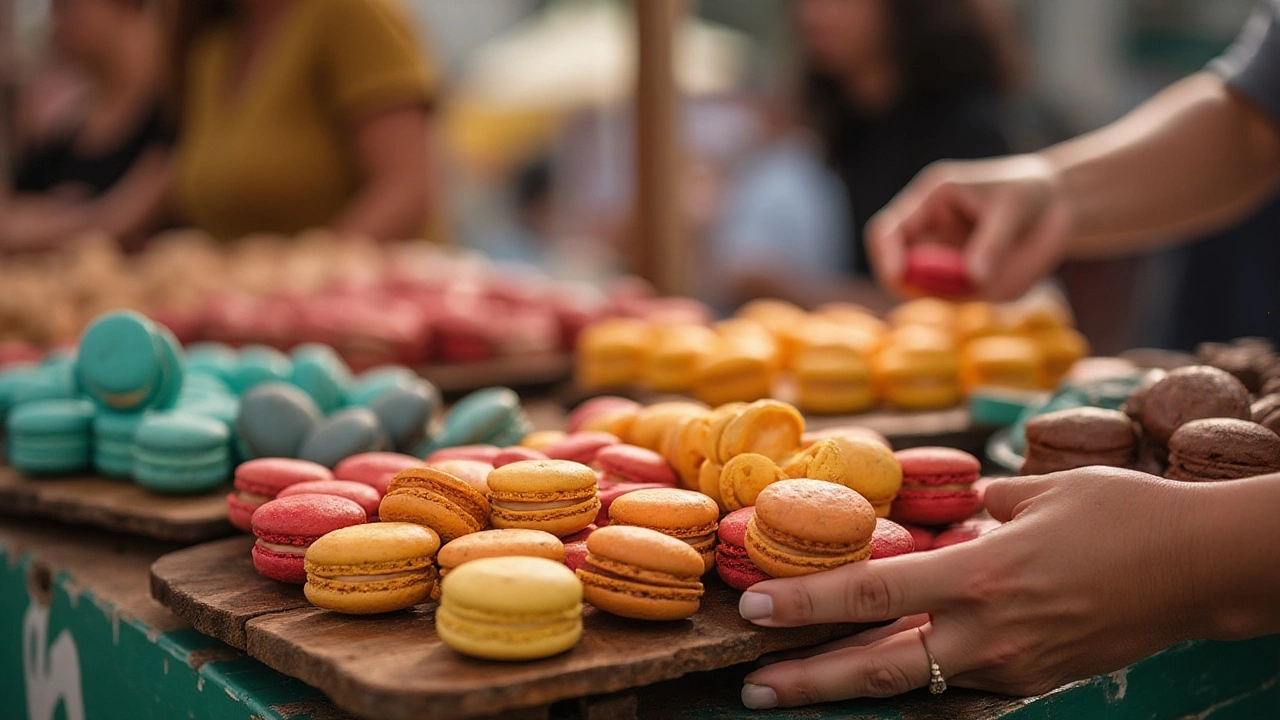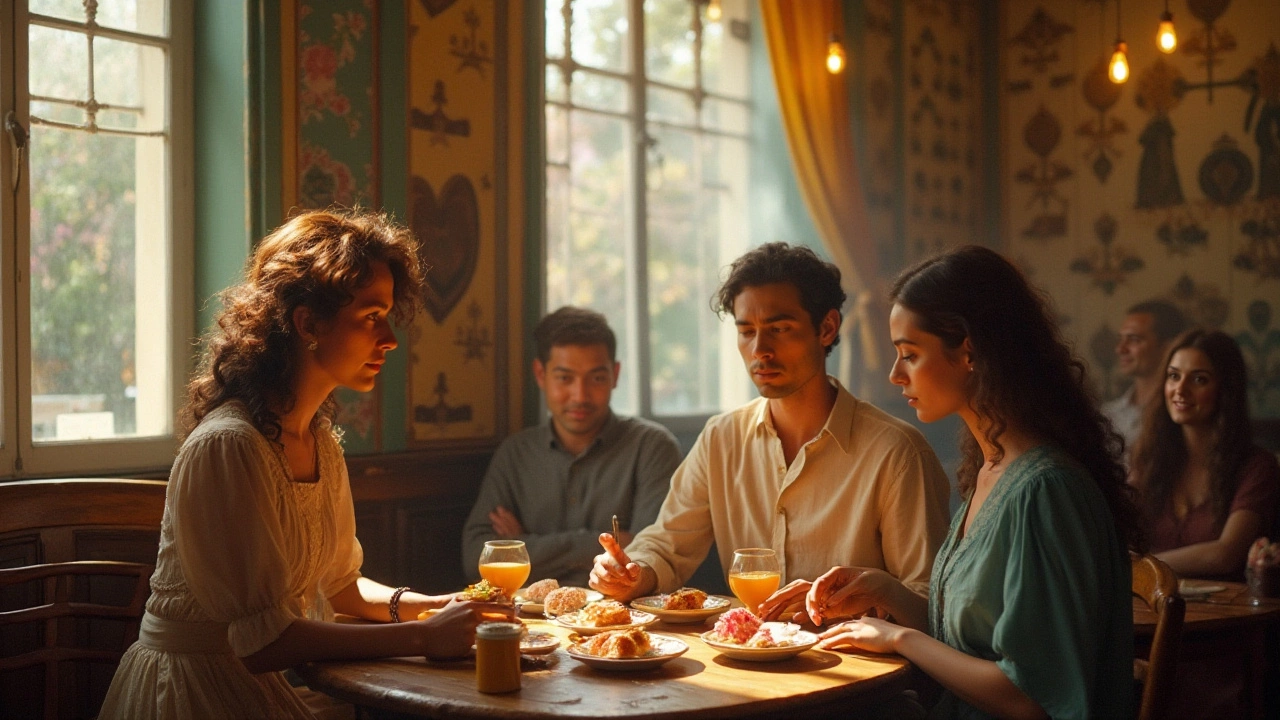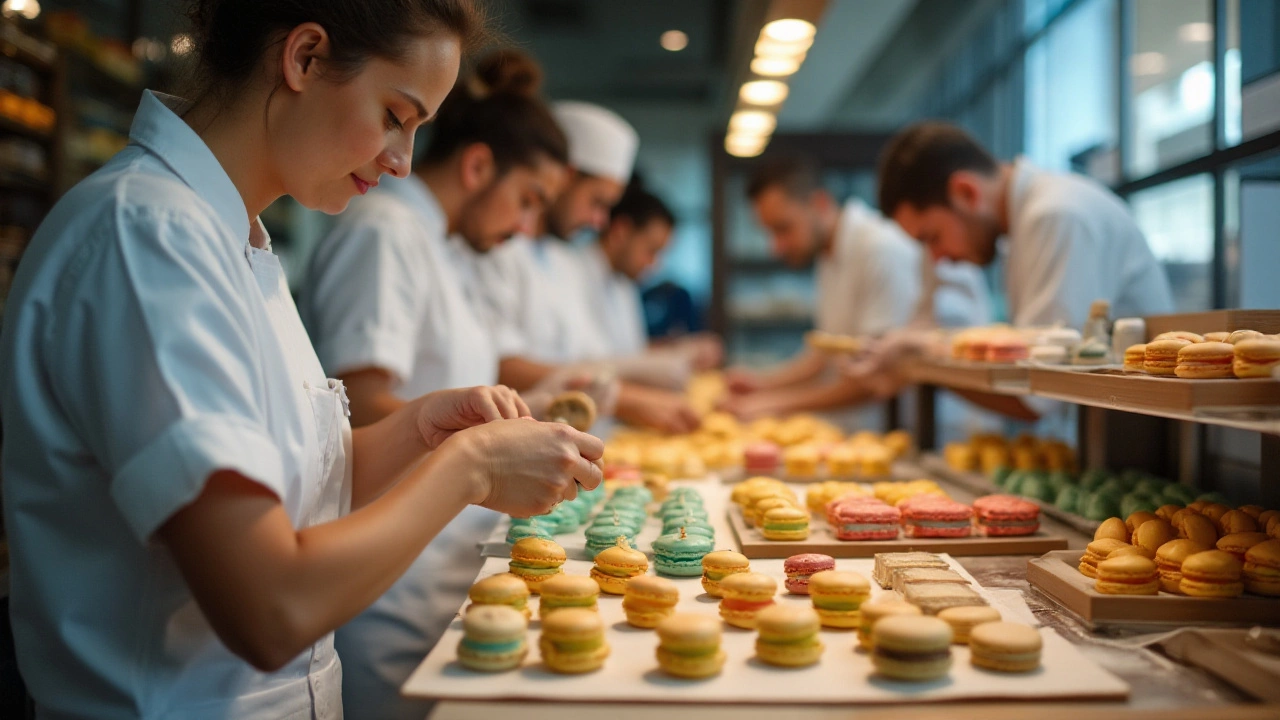
Macarons have transcended the borders of France to become a beloved delicacy worldwide, and their journey to Brazil is a sweet tale of cultural exchange and culinary evolution.
Initially a European novelty, these tiny, flavorful confections captured imaginations long before landing in South America. The curious minds have often pondered, who first brought macarons to Brazil? And how did these dainty treats manage to weave themselves into the vibrant tapestry of Brazilian gastronomy?
In this fascinating exploration, we delve into the history, migration, and the personal stories of those who helped macarons flourish in Brazil, while offering tips on savoring the finest examples in the nation today.
- The Origin of Macarons
- Macarons Around the World
- The First Arrival in Brazil
- Who Brought Macarons to Brazil?
- The Rise of Macarons in Brazilian Culture
- Where to Find Macarons in Brazil Today
The Origin of Macarons
Long before they adorned the gleaming shelves of Brazilian patisseries, macarons had their humble beginnings in Europe. Stepping back to the early days, we find ourselves in the charming streets of Renaissance Italy, where a simple almond biscuit, believed to be the precursor to the macaron, first made its debut. Often credited to the culinary creativeness of monasteries, these biscuits were born as a result of using ground almonds, sugar, and egg whites, a staple that formed the basic trinity of the macaron ingredients we savor today. Historical records suggest that this confection was later brought to France by Catherine de' Medici's pastry chefs when she married Henry II of France in 1533. This certainly planted the first seeds of what's now a worldwide fascination.
As the centuries rolled by, this basic almond meringue transformed into a delicacy that gained popularity among French aristocracy. It wasn't until the 18th century that macarons began to take on a more familiar shape and flavor profile, particularly in the region of Nancy, credited to the Sisters Marguerite and Marie-Elisabeth, who produced macarons to support their convent. Their macarons became so famous that they were referred to as the 'Macarons of Nancy,' a tradition carried into the modern pastry scene. In Paris, macarons took a further leap through the creative hands of Pierre Desfontaines of the renowned Ladurée, who had the brilliant idea of sandwiching two meringues around a creamy ganache filling, thus transforming this time-honored treat into the dual-colored and textured marvel we cherish today.
"Macarons are not just another pastry; they represent the artistry of patisserie, a balance of flavor, texture, and color," notes Pierre Hermé, a celebrated French pastry chef.
The perfection of this craft has seen regional variations springing up over time. Technological advances and the global exchange of culinary ideas have driven the evolution of the macaron, steadily expanding their flavor repertoire beyond the traditional almond, pistachio, and chocolate. Today, one can find macarons in a dazzling array of flavors, from lavender and rose to unique regional twists like black sesame in Asia and passionfruit in South America – illustrating how the macaron has truly become a canvas for creative expression. The journey of the macaron from its simple origins to a luxurious, often highly stylized delicacy, is a testament to how culture, history, and art intertwine in the world of dessert making.
| Year | Milestone |
|---|---|
| 1533 | Macarons introduced to France by Catherine de' Medici's chefs |
| 18th Century | Popularized in Nancy, France by the Sisters of Nancy |
| 1930 | Pierre Desfontaines introduces the modern sandwich-style macaron at Ladurée |
Macarons Around the World
When one thinks of macarons, an image of pastel-colored, delicately crafted treats often comes to mind. These pastries have traversed the globe, igniting a love affair with dessert enthusiasts everywhere. Their journey started in Europe, where the art of creating macarons was first perfected. From Parisian patisseries to bustling metropolises across continents, macarons have become synonymous with sophistication and indulgence. While Paris may still be deemed the unofficial macaron capital, these confections have made their mark far and wide. Each country has embraced the macaron with its unique flair, adapting flavors that resonate with local palates. In Japan, for instance, green tea-infused macarons have captured the hearts of many with their subtle blend of tradition and modernity. Meanwhile, in Italy, macarons occasionally incorporate almond-based amaretti, paying homage to native ingredients.
The United States wasn't far behind in the macaron craze, with bakeries such as Ladurée opening in key cities like New York. Macarons' growing popularity in America led to a surge in creative interpretations, with flavors ranging from maple bacon to earl grey. This international admiration speaks volumes about the macaron's universal appeal. However, it hasn’t always been smooth sailing for these desserts as they traveled across borders. Transporting macarons requires meticulous care due to their delicate structure. Well-crafted boxes and temperature-controlled environments are often employed to maintain their quality and presentation. This careful consideration highlights the macaron's status as a pastry that deserves nothing less than the best treatment. The way macarons have integrated into various cultures truly showcases the adaptability and spirit of culinary exploration that transcends language and customs.
The impact of macarons worldwide often trickles down into cultural festivals and culinary events. National Macaron Day, celebrated on March 20th, stands testament to the macaron's global reach. On this day, patisseries around the world offer free samples and even host macaron-making workshops. This collective appreciation mirrors how a seemingly simple dessert can forge connections across cultures. Such events serve not only as a tribute to the macaron's journey but also to the craftsmanship that goes into every single piece.
"Macarons are a testament to the power of culinary art in bridging cultural divides," says renowned pastry chef Pierre Hermé.His perspective encapsulates how desserts nurture common ground, delighting taste buds while transcending geographical boundaries. Thus, the journey of macarons across the globe is as vibrant and colorful as the treats themselves, continually evolving with every new flavor and regional adaptation.
While the rise in popularity is impressive, it’s the meticulous artistry involved that sustains the international allure of macarons. Chefs and bakers from diverse backgrounds undertake countless trials to achieve the perfect texture—a seamless balance between chewy, crisp, and tender. Special attention is especially paid to achieving flawless 'feet,' the ruffled base of the shells. These distinctive features define a successful macaron and serve as a symbol of pâtisserie excellence. The mastery involved often requires an in-depth understanding of climate, as changes in humidity can affect the outcome. Therein lies the admiration for the humble macaron, whose complex simplicity defies its modest appearance. With each country bringing its innovation into the macaron arena, we see endless possibilities supported by a shared passion for culinary excellence.

The First Arrival in Brazil
The mid-20th century marks a significant period in the story of macarons reaching Brazil. The introduction of this French delight is often credited to the country’s growing cultural exchanges with Europe post-World War II. It was a time when chefs and patisserie enthusiasts traveled extensively, bringing with them the knowledge and techniques they had acquired abroad. Macarons, with their vibrant colors and delicate textures, first made their appearance in high-end restaurants and elite gatherings, earning immediate popularity among the curious aristocracy and affluent locals.
Initially, the availability of authentic French ingredients posed a challenge, confining macarons to larger cities like Rio de Janeiro and São Paulo, where there was access to imported goods. Enthusiastic pâtissiers began experimenting, substituting local ingredients to mimic that iconic taste. The tropical climate added a unique set of challenges, as the humidity required alterations in the preparation to maintain the ideal texture. Over time, through trial and error and the willing tastebuds of adventurous eaters, local variation of macarons began to emerge; they were different but quite delightful in their own right.
A famous instance was when renowned Brazilian chef, Luiz Cintra, remarked, "Brazil didn’t find macarons, macarons found Brazil. Its essence is much like the people – colorful, vibrant, and with layers of flavor." This sentiment captures the spirit of how macarons seamlessly blended into the culinary fabric of Brazil.
The real watershed moment came during the early 2000s when the gourmet food trend swept across Brazil. This period saw an influx of specialized bakeries and patisseries, dedicated to creating macarons that could boast not just of being French-inspired but authentically Brazilian, reflecting local tastes and preferences. Chocolate and coffee variants began to gain momentum, capitalizing on Brazil's rich heritage in these ingredients. As the demand surged, small artisanal shops began to sprout in unexpected places, making high-quality macarons accessible to a broader public. The once foreign delicacy was now a sought-after treat embraced by Brazilians everywhere.
It is fascinating to observe how something so quintessentially French could find a home thousands of miles away in Brazil. The journey of macarons into Brazilian life echoes the global love for this dessert that defies borders and blends cultures together, demonstrating that these meringue-based treats, much like art and music, transcend the mere boundaries of geography.
Who Brought Macarons to Brazil?
It is often said that a taste can transport you to a place you've never been, and in the case of macarons, this sweet sensation took its culinary journey to Brazil via passionate individuals with a penchant for desserts. The story of how these colorful confections arrived in Brazil is less about a single person and more about the synergy of gastronomic exploration in recent decades. Some credit the rise of macaron popularity in Brazil to the pioneers who recognized the universal appeal of French patisserie and saw in it an opportunity to introduce something novel to the Brazilian public. These were budding chefs and ambitious entrepreneurs, influenced by their travels and international training, eager to bring an authentic yet aesthetically pleasing taste of France into local patisseries.
One notable figure was Chef Pâtissier Adriano Zumbo, whose exposure to global baking trends played a pivotal role in crafting macaron menus that would tickle the taste buds of Brazilians. Despite being an Australian-based chef, his connection with South American culinary circles was strong enough to create ripples across the continent. Many also point to Brazilian pastry chef Pierre Hermé's influence. Known as the Picasso of Pastry, he inspired a generation of local chefs with his inventive approach to macarons, blending classic techniques with Brazilian flavors like passionfruit and açaí. This ingenuity helped pave the way for the acceptance and appreciation of macarons as more than just desserts, but rather as an art form.
"The beauty of macarons is in their simplicity and elegance," remarked renowned Brazilian chef Helena Rizzo, hinting at how the aesthetics of these treats played a crucial role in wooing a market that values craft and color.
The blending of French sophistication and Brazilian exuberance took place within the kitchens of urban centers like São Paulo and Rio de Janeiro, where culinary schools rapidly adapted to include French pastry fundamentals as core components of their syllabus. They encouraged students to master the delicate balance between the macaron’s compelling appearance and its intricate flavor combinations. This exploration resulted in macarons gaining a distinguished presence at weddings, corporate events, and in upscale bakeries across Brazil.
The trend of macarons in Brazil aligned with a broader global fascination with Instagrammable food. Their vibrant hues and exquisite shapes made them perfect for social media, propelling their popularity beyond food enthusiasts to the digital domain. Savvy bakers in Brazil seized this opportunity, offering not only the traditional flavors but also Brazilian-inspired versions, incorporating local ingredients like cupuaçu or Brazilian nuts, much to the delight of gourmets who appreciated a local twist on an international favorite.

The Rise of Macarons in Brazilian Culture
The arrival of macarons in Brazil ushered in a new era of dessert appreciation, blending the timeless elegance of French patisserie with the vibrant zest of Brazilian culinary traditions. Initially, macarons were considered a foreign luxury, reserved only for exclusive events and affluent customers. But their colorful appearance and diverse range of flavors quickly captured the hearts and palates of Brazilians across the socioeconomic spectrum. The growth was more than just about taste; it was about cultural exchange and culinary innovation.
In many urban centers, particularly São Paulo and Rio de Janeiro, bakeries began experimenting with local ingredients, giving macarons a distinctly Brazilian twist. Flavors such as passion fruit, pineapple with coconut, and even brigadeiro – a classic Brazilian chocolate truffle – started to emerge, captivating a diverse audience and demonstrating the creative potential of macarons. This fusion not only showcased the adaptability of the macaron but also highlighted Brazil's knack for integrating global trends with local tradition. As macarons began gracing the menus of chic cafes and patisseries across the country, their accessibility grew, making them a staple at family gatherings and celebrations.
According to culinary expert Maria Eduarda, who has studied the rise of global desserts in Brazil, "The adaptation of macarons to fit the Brazilian palate is a testament to our ability to embrace and transform foreign cultural elements into something uniquely ours." Her insights reflect a broader trend in which global desserts are localized, lending them newfound popularity and meaning. This observation is particularly evident in Brazil's approach to desserts, where the macaron's versatility has allowed it to seamlessly fit into a range of culinary contexts, from fine dining establishments to casual gatherings.
"The Brazilian reinterpretation of the macaron is a perfect example of how culinary globalization can enrich local food culture," Maria Eduarda explains, "It's an exchange that benefits both the global and local palate alike."
The increasing demand for these delicate delights has also spurred entrepreneurship and innovation within the food industry. Small businesses and artisanal pastry chefs seized the opportunity to create and sell macarons at local markets and online, turning what was once a niche product into an accessible indulgence. As these colorful confections continue to gain traction, they symbolize more than just a tasty treat; they represent a shift towards a more interconnected culinary world. The rise of macarons in Brazil is thus not merely about their spread as a food item but encompasses a deeper cultural resonance, highlighting Brazil's openness to global influences and its ingenuity in making them their own.
Where to Find Macarons in Brazil Today
In present-day Brazil, the colorful and delicate macarons have firmly entrenched themselves as a sought-after delicacy, delighting sweet-toothed enthusiasts from São Paulo to Rio de Janeiro. While these French desserts have made rounds across Brazil, their presence is most strongly felt in bustling urban areas where culinary trends tend to catch on swiftly. With an increasing number of specialty pastry shops popping up, one is never far from a place that offers these sweet treats.
In São Paulo, a city often known for its cosmopolitan flair and dynamic food scene, finding a high-quality macaron is hardly a challenge. The city boasts several patisseries that are famous for whipping up authentic French-inspired desserts with a Brazilian twist. For instance, some patisseries infuse local flavors such as passion fruit, coconut, and guava into their macarons. These creatives turn traditional recipes on their heads, resulting in macarons that resonate well with local palettes. Meanwhile, in Rio de Janeiro, the beaches are not the only attraction. The city offers shops by the coastal promenades where one can enjoy a macaron while taking a leisurely evening stroll, capturing the essence of vibrant city life wrapped in delightful bites.
Shops like Brigadeiros by Fabiana D'Angelo, although primarily known for their brigadeiros, have ventured into the world of macarons, creating hybrids that celebrate Brazil’s love for fusion desserts. In the south, Porto Alegre is another thriving hub where artisanal market culture encourages bakers to experiment with their offerings, often showcasing macarons that reflect regional tastes. Here, the locals enjoy macarons paired with strong, aromatic Brazilian coffee, creating an indulgence for both tourists and locals alike.
Given the competitive landscape, quality is not sacrificed; many shops use imported ingredients to ensure the authenticity and integrity of macarons. As reported by Brazilian culinary expert Marcelo Cotrim, "The use of premium almond flour and precise baking conditions is what makes a macaron truly exquisite. In Brazil, we've maintained the tradition while introducing elements that speak to our culture."
If you are in Brazil and craving a macaron adventure, turning to online resources can be immensely helpful. Several blogs and food guides are dedicated to rating and reviewing the top spots to indulge in these French confections across Brazilian towns and cities. Through delivery apps and platforms, it’s also possible to have your favorite macarons delivered to your doorstep. The convenience has added to the popularity, making it easier than ever to embark on this delightful culinary discovery.